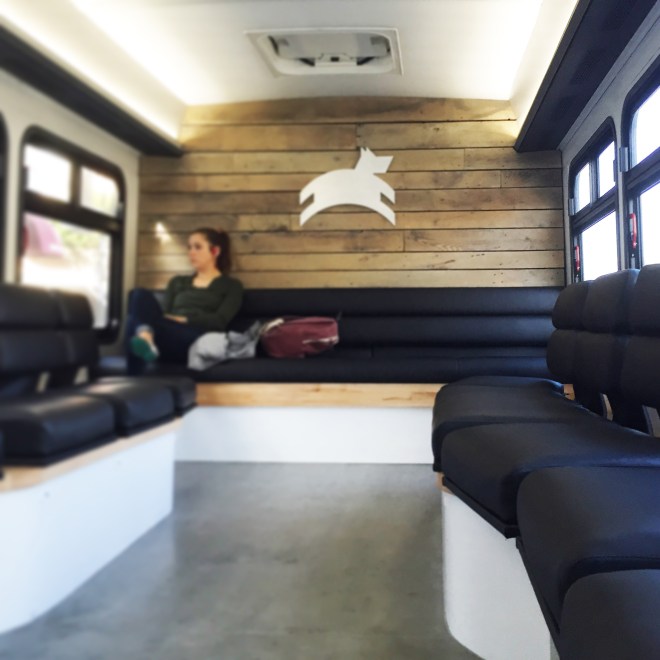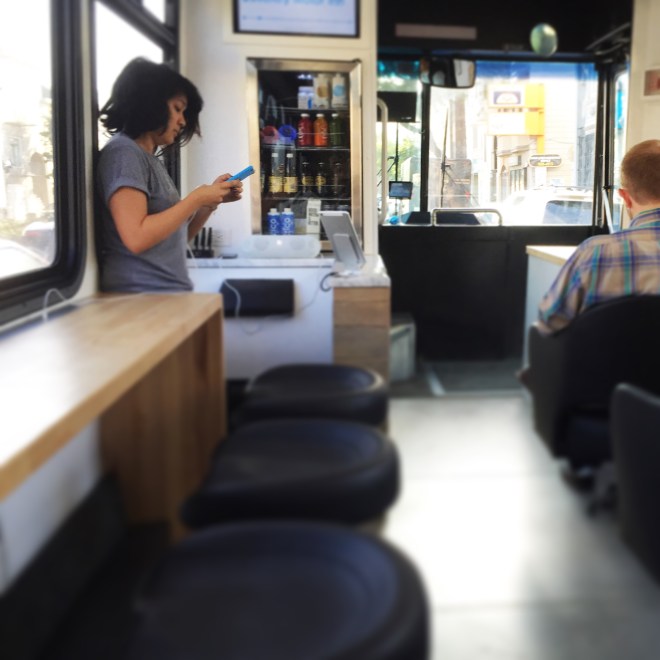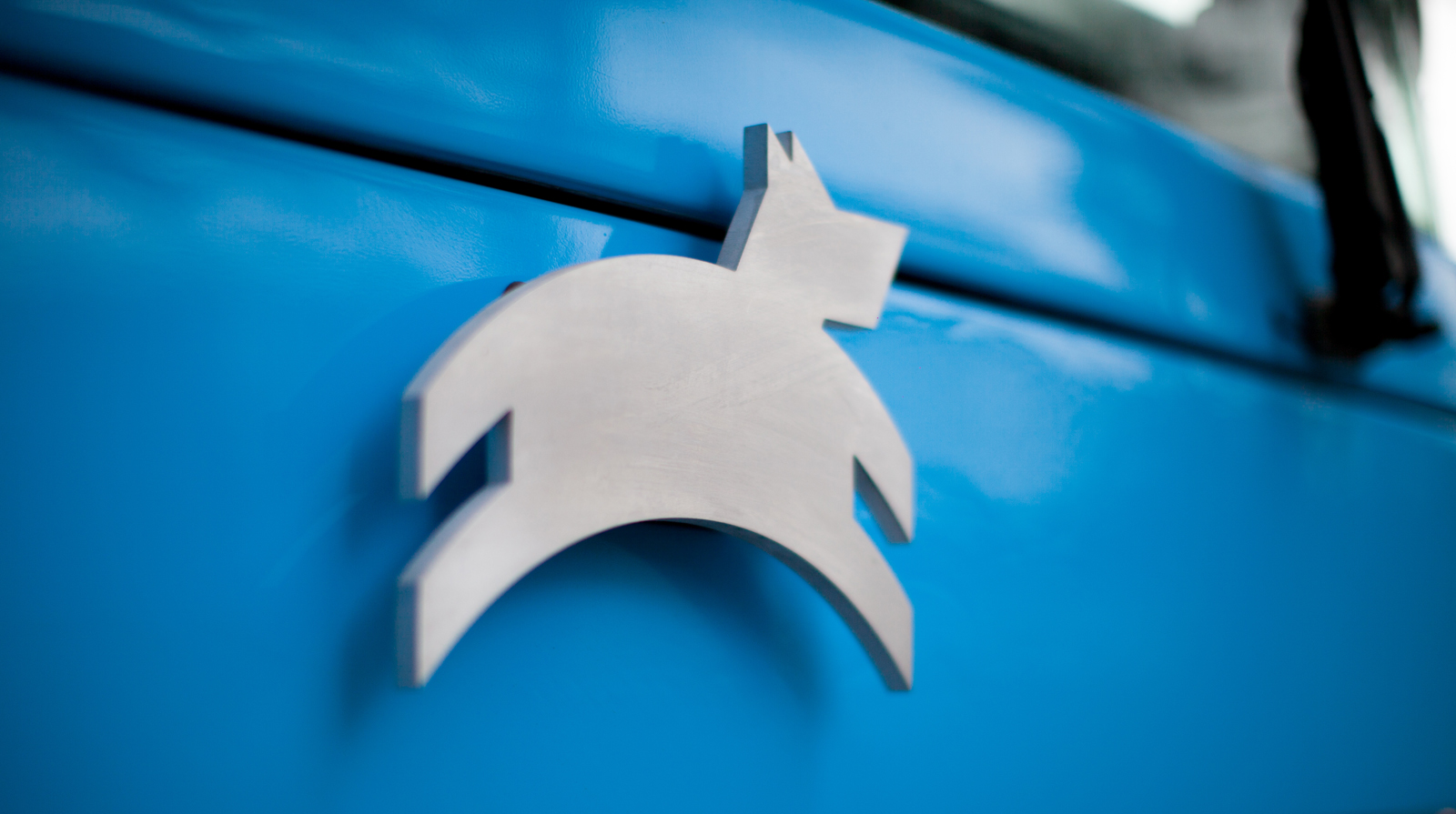Not too long ago, I wrote about a new bus that arrived in San Francisco. It was a fancy bus made by and for the kind of people who work at and finance tech startups. It was called Leap, and it had a cute logo that was a sort of dog/fox thing jumping in the air. It had distressed wood paneling and artisanal coffee and an actual counter inside with barstools. It cost $6 for a one-way ticket.
I kind of made fun of it. I think the line I used was, “Finally! A bus as pretentious as you are!”
What I neglected to mention was that, pretentious or not, I’ve always found transit, in all its forms, to be pretty cool. I grew up in suburban Detroit, a metropolitan area that could, charitably, be described as “transit-deprived.” When I was a small child, we went on a family vacation to Toronto; I am sure this trip featured many child-friendly attractions, but all I remember was the subway. It was thrilling. So many different people! Straps hanging from the ceiling!
When I first moved to San Francisco, I was so entranced at living in a city that had public transportation that I would ride around on it without knowing where it was going, just for fun. Even after the magic wore off and city transit became mundane, I stayed a tourist. In New York, I have taken the 6 to the end of the line, just to get a glimpse of the old City Hall subway station. I not only know what a funicular is, but I have gone out of my way to ride one.
Which is good, because I am going to have to go out of my way to ride Leap, too. Unless you are in Leap’s target demographic (resident of the well-to-do Marina and Pacific Heights neighborhoods in the northwestern part of the city, working in the Financial District downtown), getting to Leap isn’t easy. The bus only makes stops going in one direction — into downtown in the morning, and then back into the neighborhoods in the evening. Since I do not live in the Marina or Pac Heights, I will have to take a city bus to get to the start of the line. That should take me about half an hour, my phone estimated.
My first city bus didn’t show. Everyone waiting outside the bus shelter looked nervous — possibly because, inside the bus shelter, there were two grizzled men drinking tall cans of beer, wearing moving blankets as though they were capes, and having a very enthusiastic conversation that seemed like it might be drifting into barfight territory. I walked four blocks over to another stop, where the bus pulled up right on time. In the front, the driver chatted with a man in an electric wheelchair as the man gingerly tried to parallel park in the designated wheelchair area. In the next seat over, a little boy who had been carefully dressed in the apparel of the Bay Area hipster child (independent record store clerk, circa 1990) worked hard to impress his exhausted-looking nanny with a popsicle-stick sculpture.
It occurred to me that I wouldn’t be seeing either of them — the man, or the child — on Leap, which doesn’t have wheelchair access and bans children. Behind me, a man cheerfully expounded on the failings of the skateboarder on the street outside. “He’s got a brake on that thing!” he laughed. “That’s not cool. Skateboarding has to be dangerous!” I almost never ride the bus anymore, since I can bike nearly anywhere in the city faster than a bus can get there, but I realized that this — all the little spontaneous conversations and interactions around me — was something I missed.
The San Francisco Municipal Railway (aka Muni) is a little over 100 years old. When it started, in 1912, it was the first publicly operated street railway in a large city. As in most cities, San Francisco’s first transit lines were started by private companies, and the public and private operated together in the same city for decades — most notoriously on Market Street, which was dominated by streetcar tracks owned by competing companies. In 1944, the last of the private companies — the Market Street Railway — decided there was no money in transit anymore, and sold its fleet to Muni. After that, Muni kept any potential competition down, most notably when it successfully lobbied the city to stop issuing new licenses for jitneys in the ’70s.
Muni argued that since it was willing to keep operating a mass transit system even when there was no money in it, it deserved an unrestricted monopoly on that system. That reasoning held until a few years ago, when a small group of well-funded and politically connected startups began to use the location capabilities of smartphones to start their own transportation networks, and were able to lobby their way out of getting shut down. In the process, they created a new category for themselves — Transportation Network Company, or TNC. The introduction of carpooling services like Lyft Line and Uber Pool, and in particular the shuttle services Loup and Chariot, have brought the city even closer to this old mishmash of private and public transit systems.
The effect of all this on Muni is as-yet-unknown. But in general, Muni ridership per capita is sliding, even while usage of the area’s long-distance transit — Caltrain and BART — continues to skyrocket.
The next bus I needed to transfer to was late, too — and packed, with a crowd that appeared to be half office workers and half day laborers. I stood and looked at the advertisements that ran along the bus ceiling. “Buy yourself some time. Literally” — that’s an advertisement for TaskRabbit. “What if the Internet was built just for you?” That’s StumbleUpon. As I idly wondered what the internet really would be like if it were built just for me, the bus turned and began going down a different street. It dawned on me that, however late my bus was, I should never have gotten on the first bus that showed up without looking at the sign first. I was on the wrong bus. Rookie mistake. The journey that my phone said would take a half hour would be well over an hour long now. I got off at the next stop, and walked the rest of the way.
Leap has no schedules, but once you’ve downloaded the app onto your phone and given it a credit card number, you can watch the tiny bus icons move toward and away from you. What Leap does have are its own bus stops — these new transit companies have failed to negotiate the use of Muni’s bus stops the way that the tech buses did earlier. As I stood at the stop and watched the tiny Leap bus icon move toward me, two Google buses bound for Mountain View and one city bus pulled up at the Muni stop a few feet away. If I was actually in a hurry, I would be on the city bus already, headed downtown. I kept waiting and, sure enough, a small blue and white bus pulled up. The doors opened, and I stepped inside.

Heather Smith
In accordance with the law of all things in the universe that aspire toward hipness, there was a sound system, and that sound system was playing “Get Down on It” by Kool & the Gang. Everything was either shiny and white, or covered in distressed wood or black pleather. It felt like the future, but a lonely one — the bus was empty except for a woman sitting on a black pleather sofa in the back, texing angrily into her phone, and a bubbly bus attendant manning the check-in station and the mini-fridge. I ordered a coffee, which turned out to be an iced coffee, probably because serving hot coffee in a moving bus is a lawsuit waiting to happen. The transaction was so smooth that I didn’t need to open my wallet — I just asked for a coffee, and it was handed to me.
At no point was it even mentioned either in the Leap app or in real life how much the coffee cost ($5), and this struck me as very much in keeping with the platonic ideal of e-commerce in San Francisco, where everything is set up to feel like a gift between friends, even when it isn’t. I sat down at the counter that ran along the length of the bus on one side, and my vague feeling of unease turned to child-like glee, because the windows on the side of the bus were huge. Not only could I see a panorama of the city passing before my eyes; I could also look right into people’s cars as they drove by.
The bus stopped. A few more people got on. Kool & the Gang continued to exhort us to get our backs up off the wall and dance come on come on. But no one was even talking, except for the guy who stepped onto the bus while talking on his cellphone and hadn’t stopped talking since. He seemed to be saying the word “software” over and over again.
I remembered reading about a feature on Leap where shy bus riders could read more about each other using the app, but when I found that section of the app, it informed me that instead of having its own social network, Leap instead wanted complete access to my Facebook page. “Leap will receive the following,” the app screen read: “Profile, friend list, email addresses, work history. Just try it, seriously. It’s not creepy.”
I was under no illusions that I or my friends have anything approaching private lives left on any corner of the internet. And yet. And yet. Why so eager to reassure me of your non-creepiness, bus?
Buses are creepy in both good and bad ways because they put strangers in closer proximity than they would be otherwise. I know two people who caught sight of each other while they were riding a city bus together and found that neither of them could look away. They’re still an item a decade later. That’s the good creepy. The bad creepy is when you’re on the bus and someone catches your eye who you would rather not get to know, ever. Wouldn’t it be so much easier, under those circumstances, for such a person to not have access to who you and your friends are on social media? I am reminded, not for the first time, of how much new technology is designed by guys who appear to have never had the experience of being stalked or perved on, ever.
The bus turned, and my bag flew off the counter and onto the floor. As I leaned over to pick it up, I felt the distinct stirrings of motion sickness. I had been sitting on a rotating barstool drinking coffee and riding a bus through a hilly city while the landscape rolled by at an unfamiliar angle, so I had no one to blame but my own self. I actually liked this viewing-the-city-through-a-picture-window-while-sitting-on-a-barstool thing a lot — but I’m also less prone to motion sickness than most of my friends. It was becoming clear to me why more buses don’t have bar seating, no matter how cool it looks.

Heather Smith
Over the entire length of this run, Leap picked up and disgorged 10 people. I did the math. Assuming that everyone on the bus was actually a paying customer, then Leap just made about $60 for a round trip of about 30 minutes, not counting all the overhead associated with the car, the driver, and all the licensing involved. The whole enterprise has the gloss of a soap bubble. I’m reminded of the ill-fated Kozmo.com from the last dot-com boom — something that people may remember fondly, but also have a hard time believing ever existed.
The bus arrived downtown. Nearly every vehicle passing us in the last stretch of the route seemed to be a tech bus or the kind of high-end black SUV that is more often than not a Lyft or an Uber driver. Somehow, over the last decade, when most of us weren’t paying attention, a tech economy that, until recently, functioned mostly as a glorified advertising agency has developed an entire private transportation infrastructure that rivals the city’s. In the process, it is pointing at a future not unlike the distant past — one where private mass transit is as viable a business as it was in 1915.
Leap is just a blip in that larger system. But it’s also a chance to think about what has caused this shadow transit system to come about, what we can learn from it, and what kind of a city San Francisco is becoming now that we have it.



